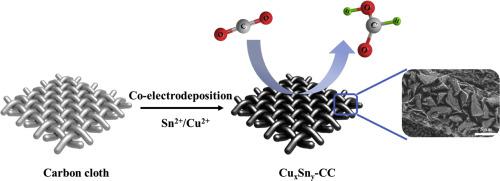Materials Today Energy ( IF 9.0 ) Pub Date : 2021-06-08 , DOI: 10.1016/j.mtener.2021.100797 Huaxin Li , Xian Yue , Yunsheng Qiu , Zhou Xiao , Xianbo Yu , Chao Xue , Junhui Xiang

|
Electrocatalysis is considered to be an effective method for carbon dioxide (CO2) reduction to formate (HCOOH) and achieving renewable energy conversion. Unfortunately, limited by the high overpotential, low selectivity, and poor stability of the existing catalysts, the electrocatalytic CO2 reduction (CO2RR) is far from practical application. Herein, we designed a series of CuxSny (x, y are the molar ratio) bimetallic alloy catalysts by the co-electrodeposition strategy for electrocatalytic CO2RR to HCOOH generation. Bimetallic CuxSny catalysts are found to be more efficient than their monometal counterparts because of metal synergistic effects. In more detail, the Cu1Sn3-CC catalyst delivers high selectivity for HCOOH evolution of above 85% over a wide potential range (−0.8 V to −1.0 V vs. reversible hydrogen electrode [RHE]) with a low onset potential of −0.6 V vs. RHE and exhibits a Faradaic efficiency of 91.38% toward HCOOH generation and a maximum current density of 13.79 mA/cm2 at −0.8V vs. RHE. Furthermore, after long-term (36 h) operation, the Faraday efficiency of the catalyst is still higher than 88.35%. This work paves a facile way to synthesize novel bimetallic electrocatalysts for efficient production of HCOOH.
中文翻译:

在共电沉积的 Cu/Sn 双金属催化剂上选择性电还原CO 2以形成甲酸盐
电催化被认为是将二氧化碳(CO 2)还原为甲酸盐(HCOOH)并实现可再生能源转化的有效方法。遗憾的是,受现有催化剂过电位高、选择性低和稳定性差的限制,电催化CO 2还原(CO 2 RR)远未实际应用。在此,我们通过共电沉积策略设计了一系列 Cu x Sn y ( x , y是摩尔比) 双金属合金催化剂,用于电催化 CO 2 RR 生成 HCOOH。双金属Cu x Sn y由于金属协同效应,发现催化剂比它们的单金属对应物更有效。更详细地说,Cu 1 Sn 3 -CC 催化剂在较宽的电位范围内(-0.8 V 至 -1.0 V 与可逆氢电极 [RHE])对 HCOOH 析出的选择性高于 85%,且起始电位为-0.6 V vs. RHE 并且 在-0.8V vs. RHE 下表现出 91.38% 的法拉第效率对 HCOOH 生成和 13.79 mA/cm 2的最大电流密度。此外,在长期(36 h)运行后,催化剂的法拉第效率仍高于88.35%。这项工作为合成新型双金属电催化剂以有效生产 HCOOH 铺平了道路。











































 京公网安备 11010802027423号
京公网安备 11010802027423号